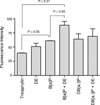Diesel exhaust influences carcinogenic PAH-induced genotoxicity and gene expression in human breast epithelial cells in culture
- PMID: 17612574
- PMCID: PMC2815343
- DOI: 10.1016/j.mrfmmm.2007.05.005
Diesel exhaust influences carcinogenic PAH-induced genotoxicity and gene expression in human breast epithelial cells in culture
Abstract
The carcinogenic polycyclic aromatic hydrocarbon (PAHs) benzo[a]pyrene (B[a]P) and dibenzo[a,l]pyrene (DB[a,l]P) are widespread environmental pollutants, however their toxicological effects within a mixture is not established. We investigated the influence of diesel exhaust (DE) on B[a]P and DB[a,l]P-induced PAH-DNA adduct formation, metabolic activation, gene expression and 8-oxo-dG adduct levels in human breast epithelial cells (MCF-10A) in culture. Following 24 and 48h, cells co-exposed to DE plus B[a]P exhibited a significant decrease in PAH-DNA adduct levels, compared with B[a]P alone, as determined by (33)P-postlabeling combined with reversed-phase high performance liquid chromatography (HPLC). Cytochrome P450 (CYP) enzyme activity, as measured by the ethoxyresorufin O-deethylase (EROD) assay and CYP1B1 expression, significantly increased with co-exposure of DE plus DB[a,l]P, compared with DB[a,l]P alone. Aldo keto-reductase (AKR)1C1, AKR1C2, and AKR1C3 expression also significantly increased in cells exposed to DE plus PAH, compared with PAH exposure alone. Cell populations exhibiting 8-oxo-dG adducts significantly increased in response to exposure to B[a]P or DE plus B[a]P for 24h, compared with vehicle control, as quantified by flow cytometry. These results suggest that complex mixtures may modify the carcinogenic potency of PAH by shifting the metabolic activation pathway from the production of PAH diol-epoxides to AKR pathway-derived metabolites.
Figures





References
-
- Dockery DW, Pope CA, 3rd, Xu X, Spengler JD, Ware JH, Fay ME, Ferris BG, Jr, Speizer FE. An association between air pollution and mortality in six U.S. cities. N Engl J Med. 1993;329:1753–1759. - PubMed
-
- Samet JM, Dominici F, Curriero FC, Coursac I, Zeger SL. Fine particulate air pollution and mortality in 20 U.S. cities, 1987–1994. N Engl J Med. 2000;343:1742–1749. - PubMed
-
- Palli D, Russo A, Masala G, Saieva C, Guarrera S, Carturan S, Munnia A, Matullo G, Peluso M. DNA adduct levels and DNA repair polymorphisms in traffic-exposed workers and a general population sample. Int J Cancer. 2001;94:121–127. - PubMed
-
- Burgaz S, Demircigil GC, Karahalil B, Karakaya AE. Chromosomal damage in peripheral blood lymphocytes of traffic policemen and taxi drivers exposed to urban air pollution. Chemosphere. 2002;47:57–64. - PubMed
Publication types
MeSH terms
Substances
Grants and funding
LinkOut - more resources
Full Text Sources
Research Materials
Miscellaneous

